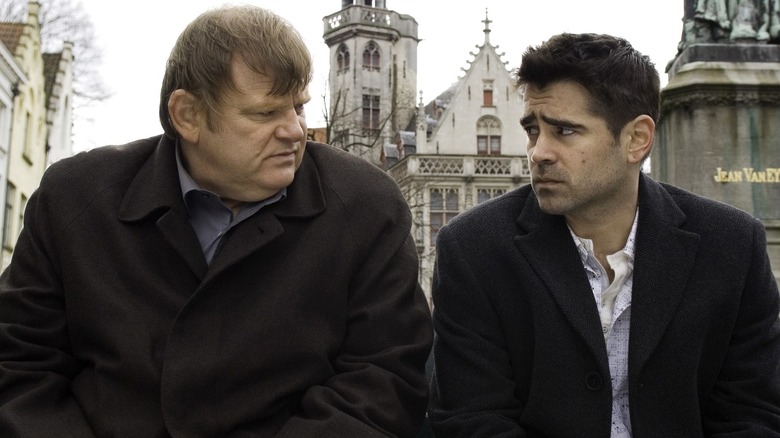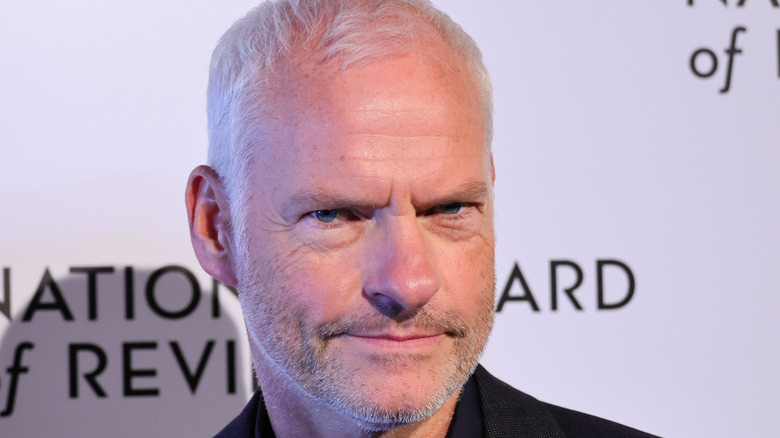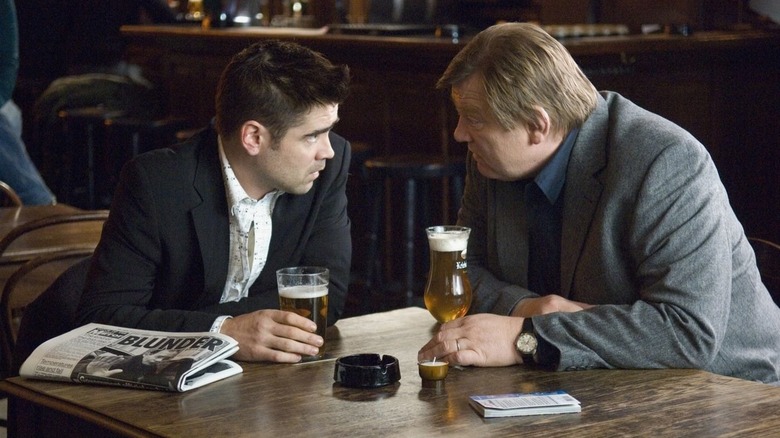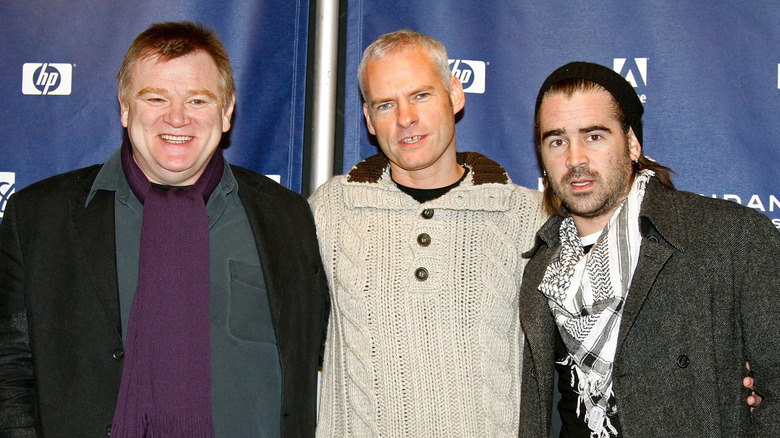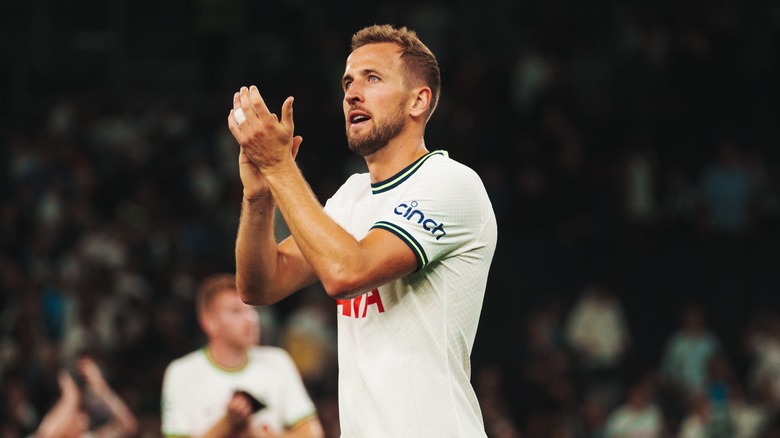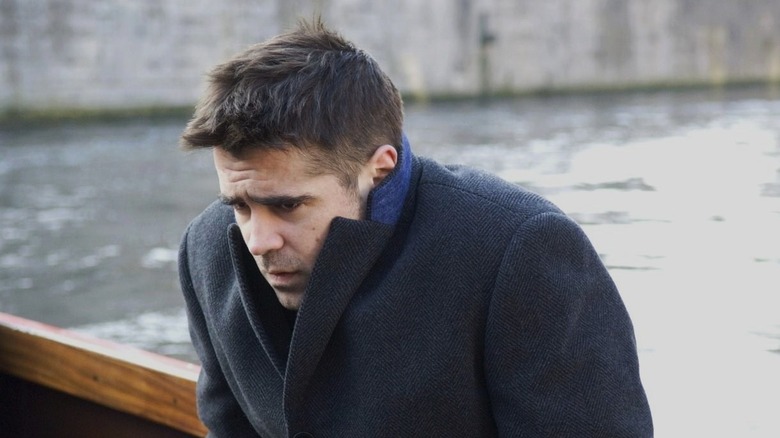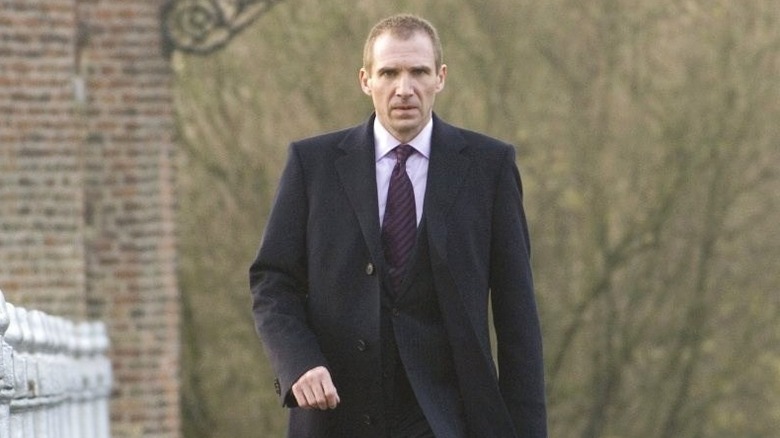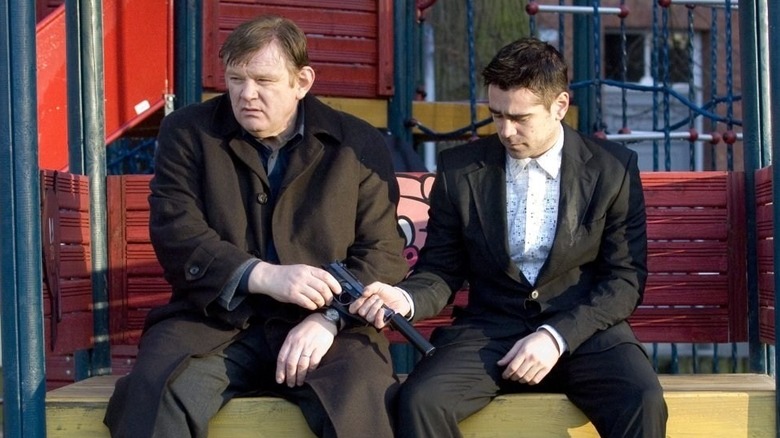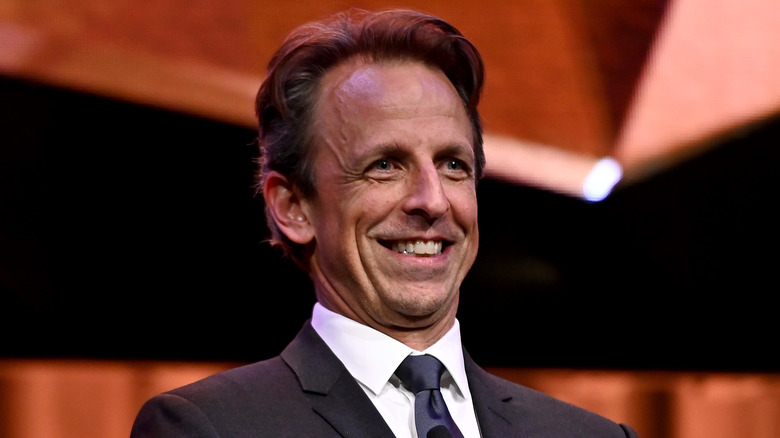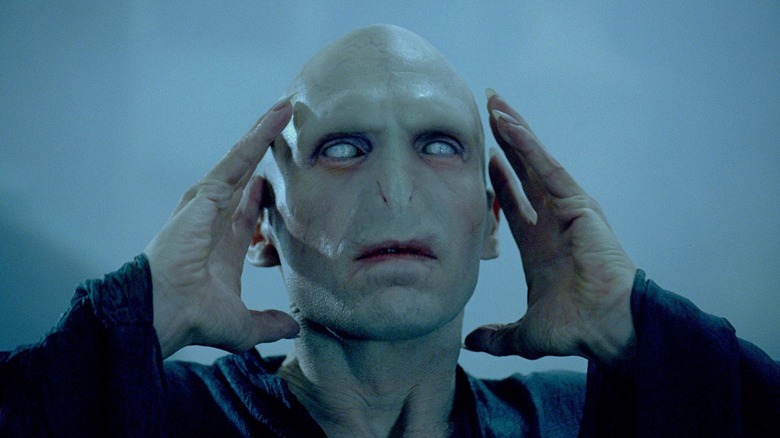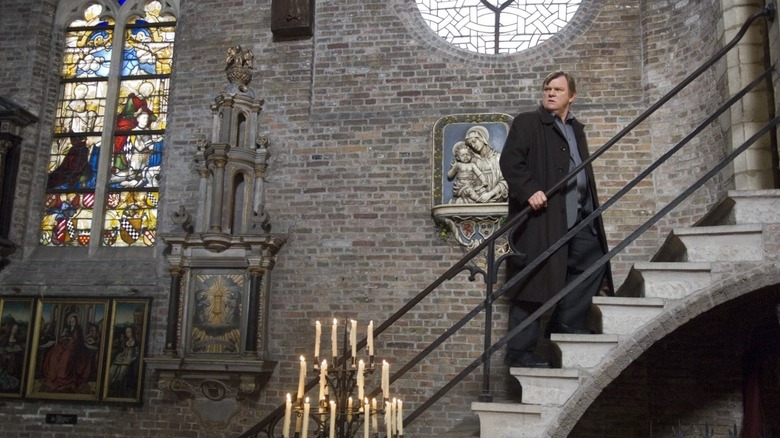In Bruges Facts That Have Been In Hiding For Far Too Long
Before they delighted audiences with their darkly comedic performances as dysfunctional friends Padraic and Colm in Martin McDonagh's "The Banshees of Inisherin," Colin Farrell and Brendan Gleeson had previously embarked on another unconventional on-screen relationship in McDonagh's 2008 directorial debut, "In Bruges." When these two actors get together under the watchful eye of McDonagh, something extraordinary happens. It may be an Irish thing or it might just be that they bring a different dynamic to the table. Whatever the reason, the two actors produce a rare, combustible chemistry that makes for the sort of viewing that doesn't come along all too often.
If you break it down to its bare bones, "In Bruges" is a movie about two hitmen in hiding after an assassination goes wrong. Yet, scratch the surface and it's a tale of the complexity of human relationships and the perpetual struggle to do the right thing.
There are no heroes or villains in "In Bruges," just complex, flawed human beings trying to amend for past mistakes and hoping for a small shot at redemption. Ray (Farrell) and Ken (Gleeson) are the most likable, chatty hitmen since Vince and Jules in "Pulp Fiction." McDonagh's script treads the fine line between realism and the blackest of comedy, and "In Bruges" is a movie unafraid of making you laugh, cry, and recoil in disgust. Here are some facts worth knowing.
In Bruges features the f-word 126 times
Just like "Banshees," there's a lot of swearing in "In Bruges." From the opening monologue, you know the air is going to be turning a vibrant shade of blue with curse words. However, even the most foul-mouthed sailor probably wouldn't expect the next 107 minutes of "In Bruges" action to contain a whopping 126 f-bombs. That's a lot of cussing, even by the liberal standards of Irish hitmen.
According to Kids-In-Mind as well as a lavish sprinkling of f-words, "In Bruges" also features a total of 17 terms referencing the human anatomy, 22 scatological terms, 8 references to sex, and 6 less offensive obscenities. The lord's name is also taken in vain on 6 occasions. In amongst the violence, gore, and substance abuse, it's not hard to see why "In Bruges" was given an R rating. Yet, the swearing is never gratuitous and is only ever used to add to the movie's authenticity and impact, as when Ray muses, "A great day this has turned out to be. I'm suicidal, me mate tries to kill me, me gun gets nicked and we're still in f******g Bruges."
McDonagh was inspired after being stood up
It may have an otherworldly, medieval, and enchanting vibe, but apart from "The Nun's Story" in 1959, "Bruges-La-Morte" in 1978, and "L'Oeuvre Au Noir" in 1998, Bruges has never been widely captured on celluloid. GQ asked Martin McDonagh if Bruges was always a prospective location for the movie, to which the director replied, "Absolutely not!" He explained that he stumbled across the Belgium capital by pure accident. "I went to Bruges for a weekend away from London. I was supposed to be meeting a girl there the next day. It was a tentative arrangement."
The lady in question never showed up, but it mattered not, because McDonagh was slowly falling in love with Bruges.
"From the moment I saw the town, I thought this place is just so cinematic, so gorgeous. Every corner seemed to offer a new image. I checked into the same hotel — the same room, actually, that the boys share, overlooking the canal," explained McDonagh. "I started walking around the center. I had a few beers. Then she phoned and said she couldn't come."
Left to his own devices, the director carried on wandering and confessed that after touring the city's museums and squares non-stop, boredom set in. That's when he hit upon the idea of making a movie about a character in a place so historical and aesthetically pleasing, but because of circumstances or disposition was bored out of his skull. McDonagh said, "He's hating it. And yet he can't leave. He's forced to stay. But why?"
Originally Ray and Ken were from London
It may feel like sacrilege now to imagine Ray and Ken with cockney accents, but it could have happened.
In an interview with IndieWire, Martin McDonagh confessed that he never writes with any one actor in mind. As such, the parts of Ray, Ken, and Harry were "written as three London gangsters." It wasn't until the opportunity of casting Farrell and Gleeson presented itself that McDonagh made the change. "I thought it was ridiculous to make them put on London accents," he said, "when it was such an easy change to make them Irish gunmen working out of London."
McDonagh elaborated that because Ray and Ken are both Irish gunmen, together in a strange city awaiting the orders of their British boss, it gives them another layer of solidarity and introduces a little more friction into the mix. Ralph Fiennes' character Harry remains the all-walking, all-snarling, and no-holds-barred personification of the London underworld. He's flash, vicious, and believes fiercely in the principles which govern his world and those who inhabit it. McDonagh explained that although he gleefully cast Fiennes against type, he knew he'd "bring an intensity and darkness and danger" to the role of Harry." Yet what surprised him most was Fiennes "Brilliant comic timing. Something I hadn't seen in him before."
McDonagh studied by binging his favorite films
Although he had a solid background in theatre, a well-respected playwright with a strong sense of the absurd, Martin McDonagh had never made a full-length feature before "In Bruges."
In a 2006 interview with the New Yorker, McDonagh revealed that it was his love for Al Pacino's performance in "The Godfather" and "Dog Day Afternoon" that motivated him to visit the first theatre for the first time in 1984; he watched Pacino on stage in David Mamet's "American Buffalo." McDonagh's second visit to the theatre was two years later, to see Martin Sheen in Larry Kramer's "The Normal Heart." In the same interview, McDonagh confessed that out of all the plays he had written only one had not been staged, because it "isn't any good." That play was called "The Banshees of Inisherin."
McDonagh revealed to IndieWire that he approached the move from stage to screen with trepidation because "I always had a healthy disrespect for theater. I always tried to write plays that a film fan, which is what I was, would like. Plays for people who don't like plays." He added that since childhood he had adored cinema and consumed the output of great directors like Scorsese, but it was more difficult to write a movie script "because of fear of that kind of company." Determined to "not make a playwright's film," McDonagh got into the groove and prepared for his directorial debut by binge-watching his favorite films.
McDonagh is haunted by the soccer team he mocked
During the scene when the two Irish hitmen are busy studying Hieronymus Bosch's painting of The Last Judgement, Ken replies to Ray's question about the nature of Judgement Day with, "Well, it's, you know, the final day on Earth, when mankind will be judged for the crimes they've committed and that." The conversation then turns to heaven, hell, and purgatory. Ray describes it as, "Kind of like the inbetweeny one," where people who weren't that bad but not that great good go, "Like Tottenham!"
The line is something of a friendly dig at North London soccer team known as the Tottenham Hotspur Football Club. Although they may have won some silverware in the past, their trophy cabinet is nowhere near as impressive as the likes of Manchester United and Liverpool. They have also never won the Premier League since its formation in 1992 and struggle to imitate past glories.
Yet, the very possibility that "Spurs" may one day enjoy a resurgence and storm to a treble-winning season continues to haunt Martin McDonagh. In a 2018 interview with GQ, he explained that even though he loves the joke and agrees with its sentiment, he is "worried it would eventually be ruined by Tottenham winning the treble. That's been a constant source of anxiety in my life. But I think I'm safe — for a while at least."
Farrell called the script the best he had ever read
McDonagh has a way with words, especially when it comes to putting them in the mouth of larger-than-life characters in a deceptively effortless fashion. This talent doesn't go under-appreciated by the actors he works with.
"Martin has a very particular voice," Fiennes says in the film's production notes. "In his writing, the humor delicately coats his completely rounded characters."
Clemence Poesy, who plays Chloe, added, "Reading the script was like entering Martin's universe — with things you've never heard or seen — and I just wanted to be a tiny part of it. I thought, 'I want to say those lines.'"
Farrell was also quick to sing the praises of the script. "There is a purity to these characters, what with their humor and how they view the world. Yes, they bring death to people, but they're not black and white." Farrell admits that he laughed out loud upon reading the script, but also found it immensely moving because he cared about what happened to the characters. "Pound for pound, it was the best thing I've ever read. Martin's got some brain on him. It's just brilliant, the characters and the situations — unique, and with amazing dialogue."
Fiennes drew inspiration from The Long Good Friday
It wasn't until he saw Ralph Fiennes on set, fully immersed in the character of Harry Waters, that McDonagh "realized how bloody scary Ralph can be." As the sharply-dressed, keen-eyed London gangster governed by a cold fury and unforgiving code, Fiennes is like a thunderstorm. Farrell described the portrayal as nuanced and funny and producer Graham Broadbent explained, "Ralph's performance shows you this chilling psychopath, but also the honor code that he has. Ralph had a lot of fun with Martin's dialogue and finding an accent with him for Harry's character."
In an interview with Ain't It Cool News, Fiennes explained that he was intrigued by the contradictions inherent in Harry's nature. He admitted that due to the quality of the writing, he found it completely plausible that Harry was both a loving family man, a sophisticated businessman, and an unapologetic killer who lived his life according to a strict code. Fiennes explained he drew inspiration for Harry by watching Bob Hoskins play charismatic crime boss Harold Shand in John Mackenzie's 1981 gangster classic "The Long Good Friday." Gripping character portrayals aside, Fiennes also admits he had the time of his life running, "down the street shooting blanks at Colin Farrell. But I could never catch up with him; he's very, very fast, and I was never a runner, so he outran me every time."
Farrell and Gleeson were longtime admirers
Much like Robert Redford and Paul Newman, Farrell and Gleeson just seem born to appear in great movies together. If "In Bruges" showed the potential, "The Banshees of Inisherin" cemented the deal.
Yet, before working together, Farrell was already a huge fan of Gleeson's work. "That was the best part of it," he said in a 2015 interview. "Seeing a certain amount of Brendan's work but then working with him and just loving that."
Although they had plenty of laughs on set, Farrell also joked it was kind of depressing, because he was playing a suicidal character who "had a lot of blood on his hands and a lot of guilt in his heart." The bromance is mutual, with Gleeson adding in the same interview that he was thrilled to be opposite Farrell. "Colin is a total dream, he really is," said Gleeson. "He's got great integrity."
Seth Meyers is sort of obsessed with In Bruges
"In Bruges" is something of a cult classic, but perhaps one of the movie's most hardcore enthusiasts is comedian and chat show host Seth Meyers. In an interview with McDonagh, Meyers confessed, "I'm a little weird about 'In Bruges.' I talk about 'In Bruges' so much people have gifted me 'In Bruges' posters." Meyers revealed that after the film he and his wife visited Bruges and "the taxi driver immediately clocked me as an American tourist who came because of the film."
Meyers then explained that there are obviously a lot of people who visit the Belgium city because of "In Bruges." When asked if the city officials had ever thanked him for the increased tourism, McDonagh replied, "I've never really been back to check." He added he believed the Mayor of the city wasn't a fan. An enthusiastic Meyers revealed he'd like to do an "In Bruges" reunion episode of his show, to which McDonagh jokingly replied it would be a great idea if the host wanted his ratings to plummet.
In Bruges features four Harry Potter actors
The Harry Potter franchise wasn't just overflowing with wizards, wands, and fake beards; it also boasted its fair share of household names from the UK film industry. Gary Oldman, David Thewlis, Richard Harris, and Kenneth Branagh were just a few of the names that popped up in the saga of the boy wizard who goes to Hogwarts and defeats Lord Voldemort. Because of the sheer number of films, and their in-demand ensembles, it isn't surprising when multiple Potter actor pop up in other films. Such films as "The Ballad of Buster Scruggs," "The King's Speech," "The Theory of Everything," "Love Actually" and "Much Ado About Nothing," for instance, all feature three stars from Harry Potter.
Then there are films like "Sleepy Hollow," "Brave," "Arthur Christmas" and "Mary Shelley's Frankenstein," which up the ante with four Potter stars. Films such as "Sweeney Todd," Paddington 2," and "In Bruges" take it to another level, going for five.
It's impressive, then, that Fiennes (Lord Voldemort), Gleeson (Alastor "Mad-Eye" Moody), Farrell (Percival Graves), Clemence Poesy (Fleur Delacour), all feature in "In Bruges," as does Ciaran Hinds (Aberforth Dumbledore), who has an uncredited bit part as the murdered priest. Even more impressive is the fact that "Tinker, Tailor, Soldier, Spy," with a total of six "Potter" alumni, beats them all.
Hieronymus Bosch's The Last Judgement is central to the film's themes
Ray doesn't really dig Bruges in the same way as his culture vulture buddy Ken.
He refuses to climb the Belfry of Bruges to enjoy the views of the fairytale city. He acts like a sulky toddler in the Basilica of the Holy Blood. When Ken asks if he wants to touch the sacred vial that supposedly contains the blood of Christ, he sullenly replies, "Do I have to?" The only thing in Bruges that appears to arouse his interest on a cultural level is when he visits the Groeninge Museum and stands in awe (or as close to awe as Ray gets) before Hieronymus Bosch's The Last Judgment. As he whispers to Ken, "I quite like this one. What's it all about, then?"
The painting's themes of judgment, both in this world and the next, and the possibility of redemption is central to "In Bruges."
"As the film progresses, Bruges becomes darker and its Gothic qualities come to the fore," McDonagh explained in the production notes for the film. "The night scenes showcase that even earlier, such as when Ray happens upon the Hieronymus Bosch-inspired movie set."
Production designer Michael Carlin added that the set is designed to resemble the Bosch painting, and that the city of Bruges plays a key part as a background character that begins as charming and accommodating, then slowly reveals itself to have another, more sinister face.
